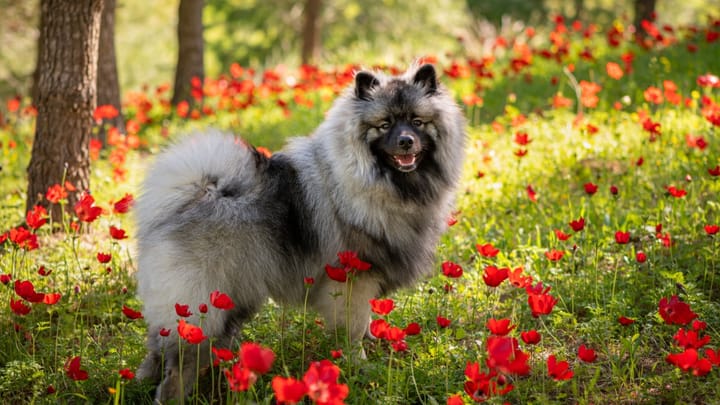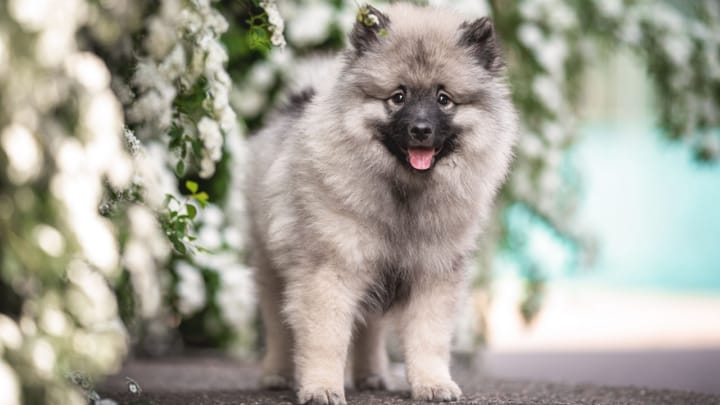Keeshond


The Keeshond, a medium-sized member of the Spitz family, is known for its lively, outgoing temperament and striking beauty. With their thick, double coats, curly tails and fox-like appearance, Keeshonds are affectionately referred to as "Smiling Dutchmen", thanks to their happy faces and endearing personalities.
|
Temperament |
|
|
Size |
Medium
|
|
Adult size |
Female
Between 16 and 17 in
Male
Between 17 and 19 in
|
|
Adult weight |
Female
Between 33 and 44 lb
Male
Between 33 and 44 lb
|
|
Coat colour
|
Black Blue |
|
Type of coat
|
Long |
|
Eye colour
|
Brown
|
|
Purchase price |
The Keeshond costs between £700 and £3000 |
The Wolfspitz is the larger German version of the Dutch Keeshond. It is considered the largest variety within the breed. The Keeshond was established in the Netherlands, where it evolved and established itself as a unique breed, used as a watchdog on barges that travel the Rhine.
More details about the Keeshond
Keeshond: Origins and history
The Keeshond is a variety of the German Spitz , an ancient breed of primitive dog . The origins of the breed remain unclear, but it is believed to be descended from the Stone Age bog dogs found in the Arctic regions. Possible ancestors include the Samoyed, the Chow Chow, moose dogs, and the Pomeranian. The Keeshond first originated in the Netherlands in the 17th century.
In the 18th century, the breed became the symbol of the rebellion led by Cornelis de Gyselaer, nicknamed "Kees", against the House of Orange in the Netherlands. The name "Keeshond" (Kees' dog) is said to have come from this period. Between the 17th and 18th centuries, the Keeshond was used as a guard dog on barges transporting goods along the Rhine.
The breed then experienced a period of decline before being revived in the 20th century, thanks to the efforts of Baroness van Hardenbroek. The first breed club was created in 1930 in the Netherlands and the standard, which has since been made official, has not changed. The Keeshond was recognised in France in 1935. Since 1999 the breed has shared the breed club standard with the German Spitz.
Keeshond: Characteristics
Keeshond: Behaviour
Training a Keeshond
With consistency and patience, the Keeshond is very easy to train.
Keeshond: Lifestyle
Breed compatibility Keeshond
Keeshond: Purchase price
Keeshonds can cost anywhere from £700, depending on the breeder, the bloodline and the location of the litter. In addition to the initial cost, you'll need to factor in monthly expenses for anti-parasite treatment, a high quality diet, accessories and pet insurance.
Keeshond: Shedding
Heavy !
The Keeshond, with its thick double coat, sheds moderately to heavily.
Keeshond: Grooming
Daily brushing is essential during the moulting season to prevent matting and to maintain coat health. Outside of these times, weekly brushing is usually sufficient for regular maintenance.
Keeshond: Health
Keeshonds are typically robust and hardy dogs with good general health. The breed isn't prone to major health problems.
Thanks to their thick, double coat, Keeshonds tolerate moderate heat quite well. They can find it difficult to tolerate high temperatures.
With their thick, woolly fur, the Keeshond is perfectly adapted to cold weather. The breed thrives in cold environments.
Keeshonds can be prone to weight gain, if they aren't exercised enough and fed a balanced diet.
- Alopecia (hair loss)
- Skin problems
- Hip dysplasia
- Epilepsy, hyperparathyroidism (rare)





